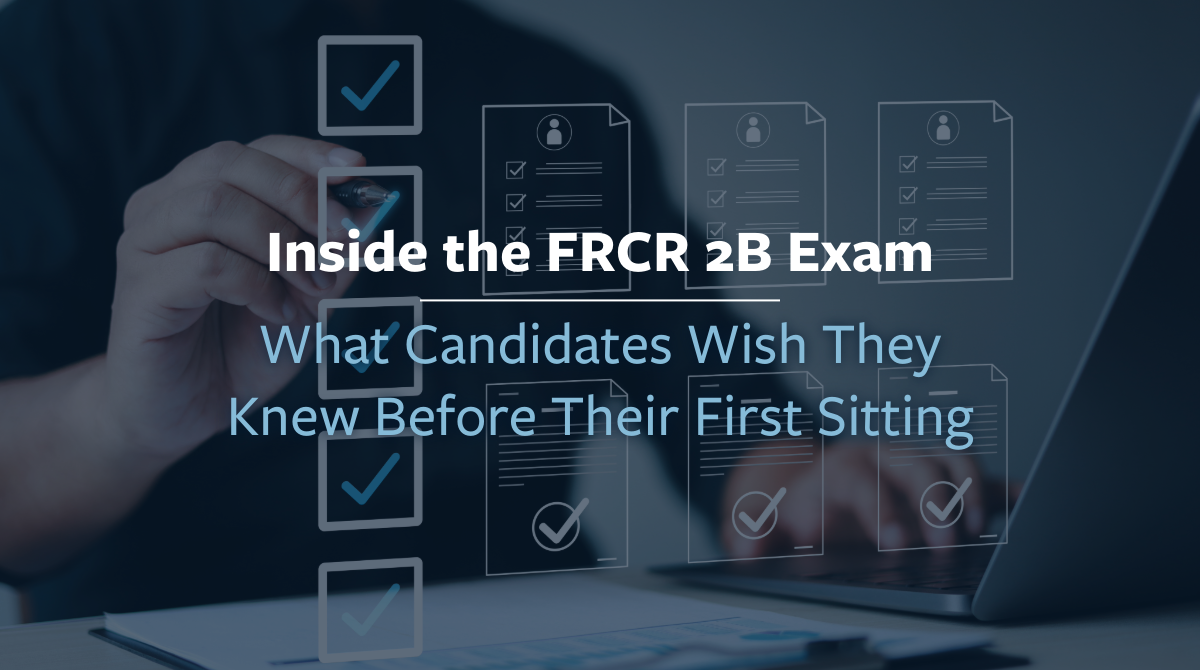
Inside the FRCR 2B Exam: What Candidates Wish They Knew Before Their First Sitting

Revise Radiology
July 25th, 2025
Sitting the FRCR 2B exam for the first time can feel like stepping into the unknown — long cases, short cases, vivas, new formats, and high stakes. But if you’re early in your prep or about to face your first attempt, here’s what past candidates wish they’d known before their exam day.
This guide blends insights from real candidates, examiners, Reddit forums, and faculty advice to give you a head start.
🧭 1. The Format Has Changed — Know Exactly What to Expect
As of June 2025, the FRCR Part 2B exam has the following structure:
🔹 Written Component
Long Cases:
6 cases in 75 minutes
Each case includes multiple modalities including CT, ultrasound, radionuclide and MR scans. Cross-sectional imaging may comprise more than one sequence, which can be scrolled through.
Candidates type their answers into an online platform
Short Cases (New Format):
25 cases in 120 minutes
Candidates will have to include a short report and recommended next steps in management in the answer field
The image can be viewed using PACS functions.
Questions can be flagged to come back to them later
📌 Important: The *short case paper replaces the rapid reporting component.
🔹 Oral (Viva) Component
Two viva exams, each 30 minutes
Conducted by two examiners per station (total 4 examiners)
You will be shown up to 8 cases per viva
Cases are projected; you’ll be expected to describe findings, offer a diagnosis, and answer follow-up questions
🎤 Tip from the RCR: Examiners expect a structured, concise presentation. They may interrupt — this isn’t a bad sign.
✅ Tips from the RCR (and What Past Candidates Wish They Knew)
Read the clinical information carefully before diving into the image
In long cases, give focused answers using the structured question format. No marks are given for general commentary or irrelevant information
In short cases, you won’t be able to scroll or adjust images — train with static image sets
For the viva, be aware that:
Examiners might use a variety of modalities (plain film, CT, MRI, ultrasound, etc.)
You’re being assessed not just on diagnosis, but your ability to reason, explain, and communicate clearlyunder pressure
Structured and logical presentation is key. Rambling loses marks. Silence is OK if you need a moment to think
⏱ 2. Time Management Isn’t Optional — It’s a Skill
The FRCR 2B exam is tight on time — and managing that time well can make the difference between passing and falling just short.
🖥️ Long Cases (75 minutes)
You’ll face 6 cases, each with structured questions.
That’s just over 12 minutes per case, and each one will likely have 3–5 questions.
Spend no more than 2 minutes reading the case and planning your answer
Allocate 2–3 minutes per question, and move on
If a question is vague, answer to the best of your ability — don’t dwell too long
🎯 Tip: Practise typing structured answers under timed conditions — this isn’t about writing essays, it’s about clarity and efficiency.
📷 Short Cases (120 minutes)
You’ll be shown 25 cases, and will have to include a short report and recommended next steps in management.
That gives you just under 5 minutes per case.
Read the clinical history carefully
View the images before typing in an the short report and recommended management
Trust your training — overthinking can cost time and marks
Flag uncertain cases and return later only if time allows
🧠 Tip: Speed matters, but don’t sacrifice accuracy — aim for calm, consistent pace rather than rushing.
🎤 Viva (2 x 30-minute sessions)
Two 30-minute viva exams with two examiners each. You’ll be shown up to 8 cases per session.
Examiners will guide you through each case
Focus on brief but structured presentations
Don’t be thrown off by interruptions — it often means you’re on the right track
Keep an eye on the clock — but trust the examiners to pace the session
💬 Tip: Practice mock vivas with strict timing. Learn to answer clearly in 1–2 minutes per case, anticipating follow-up questions.
🧠 3. Practice Delivery — Not Just Diagnosis
You can know the diagnosis but lose marks if you can’t communicate it clearly under pressure.
What helps:
Use a structured format:
➤ Observation → Interpretation → Principal Diagnosis → Differentials → ManagementPractise with peers — simulate the viva environment
Use exam-style software or mirror exam conditions when possible
“I wish someone had told me how important delivery was — not just what I saw but how I said it.”
🔍 4. Overcalling Normal Cases Is a Common Pitfall
Many candidates lose marks by reading too much into normal findings.
If you’ve reviewed an image properly and find nothing, trust that judgment.
🩻 Tip: Confidence in calling something normal is just as important as spotting the abnormal.
Practise distinguishing normal from abnormal under timed pressure — it builds confidence and efficiency.
🎓 5. It’s a Test of Technique, Not Just Knowledge
Successful candidates aren’t always those with the deepest radiology knowledge. They’re the ones who:
Present clearly
Handle pressure calmly
Use time efficiently
Stick to a structured approach
Make technique part of your prep:
Record yourself doing mock vivas
Use a timer for every case
Get feedback on how you present, not just what you say
📚 6. Resources Matter — But Don’t Get Lost in Them
You don’t need 10 question banks. Instead:
Choose one strong long case bank
Use curated short case packs that mirror current format
Watch recorded vivas to train your ear for delivery style
Join live teaching sessions or study groups to practise in real time
Look for quality over quantity — and use resources that simulate the current exam format.
💬 7. Vivas Are Nerve-Wracking — But You Can Train for That
Every candidate is nervous. The key is to build fluency, not eliminate nerves.
Try:
Practising with a friend or mentor who pushes you to verbalise under pressure
Mock viva circuits, ideally with unfamiliar people
Practising openers so you always have a confident start to each case
“I knew the answers, but I froze. After a few mocks, I learned how to get going even when I was unsure.”
🛠 8. Prepare Like It’s Game Day
During your final month:
Simulate entire exam sittings with breaks and timing
Wear what you’ll wear on the day
Practise on a computer, not a phone or printout
Review not just what went wrong, but what went well
It’s about training your body and mind for the rhythm of the real exam.
🧾 9. What First-Time Candidates Say They Regret
“I didn’t realise how structured my viva answers needed to be.”
“I spent too much time revising rare things instead of mastering core topics.”
“I ignored timing in practice, and I paid the price.”
“I underestimated how tiring it would be — pacing is everything.”
✅ Final Thoughts
Your first FRCR 2B sitting doesn’t have to be a shot in the dark.
By understanding the new format, preparing with structure, and simulating real conditions, you can go in with clarity and confidence.
You don’t need to be perfect — but you do need to be calm, structured, and time-aware.
The RSIR Exam Platform
The Revise Radiology exam platform closely mirrors the official RCR exam interface, giving you the most realistic practice environment as you prepare for the FRCR 2B.
🔗 You can preview the official RCR exam platform here:
https://www.rcr.ac.uk/exams-training/rcr-exams/exam-help-guidance/guidance-on-image-based-exam-delivery/
🧪 Want to try our platform yourself?
Create a free account and access a demo subscription for just £1 + VAT
